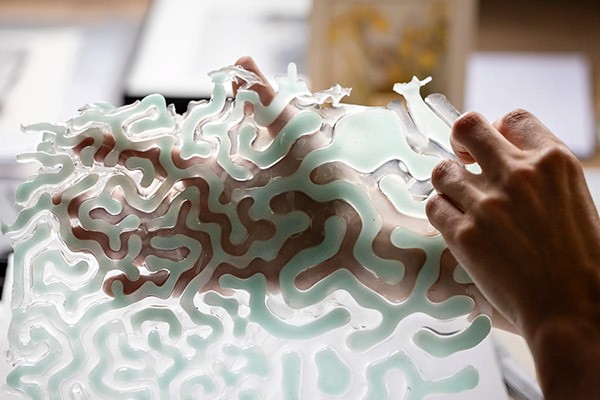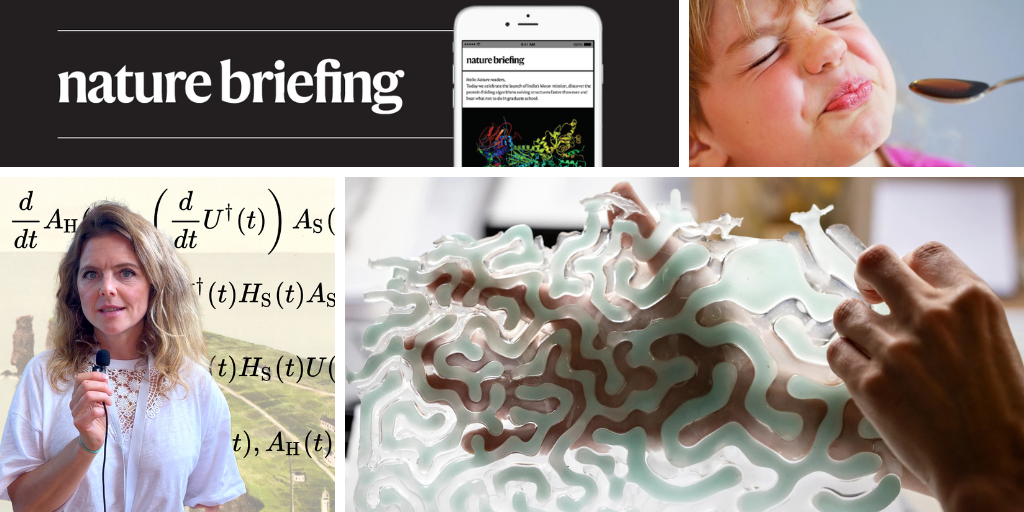You have full access to this article via your institution.
Hello Nature readers, would you like to get this Briefing in your inbox free every day? Sign up here.

(Ilvy Njiokiktjien for Nature)
Paris Haute Couture Week was brought to life on Monday — literally — by the biologically inspired designs of Iris van Herpen. One of her co-creations is a material containing tubes of living bioluminescent algae, which glow, move, respire and sequester carbon. But don’t call her work ‘futuristic’: she explores the Universe as it is, she says, along with humanity’s place in overlapping ecosystems.
Specialized intestinal cells allow Burmese pythons (Python bivittatus) to digest the bones of their prey without overloading their bodies with calcium. Researchers found that when pythons ate whole prey or were fed a calcium supplement, specialized cells in the animals’ intestinal walls accumulated particles made of calcium, which prevented too much of the mineral being absorbed into the blood. The team suggests that these cells might collect calcium and then release it to be expelled in the snake’s faeces.
Reference: Journal of Experimental Biology paper
A device combines a graphene-derived material with machine learning to detect salty, bitter, sweet and sour flavours. The system builds on previous work using atomically thin layers of carbon to detect flavours, with the added bonus that it can operate in wet conditions similar to those of the human mouth. Such a device could one day help to restore a lost sense of taste to people with neurological conditions.
The first malaria treatment specifically formulated for infants has been approved in Switzerland and will soon be available in parts of Africa. The drug, made by Novartis and named Coartem Baby or Riamet Baby, was developed with scientific and financial support from the Swiss non-profit group Medicines for Malaria Venture. It’s a new dose strength of a long-standing malaria drug, with a sweet cherry flavour and the ability to be dissolved in liquids including breast milk. Novartis says it will “roll out the medicine in the coming weeks on a largely not-for-profit basis”.
Features & opinion
Critics of ultra-processed foods (UPFs) cite growing evidence that they are linked to weight gain, diabetes, cardiovascular disease and other complications. “Food companies are actually designing products to make you overeat,” says Jerold Mande, who leads a nutrition-focused non-governmental organization. Others say that the matter is far from settled: there is no formal definition of what makes a food ultra-processed, no clear mechanisms for how these foods contribute to negative health outcomes and a lack of long-term experimental studies. Combined with chaos in the US public-health system and food-industry lobbying efforts, it’s unclear how efforts to reduce the harms of UPFs might pan out.
Funding for the ‘deaf-scientist pipeline’ — five programmes that support deaf students from secondary school to postdoctoral research in the United States — has been slashed by the termination of grants from the National Institutes of Health. Deaf students will persevere, but researchers and academic institutions must take action to support them in the pipeline’s absence, says public-health researcher Wyatte Hall, the first postdoctoral product of the pipeline.
Sentient life has moral value — but so do the intricate canyons of Mars and the storms of Jupiter, argue a philosopher and three space scientists. They urge us to go beyond “terrestrially based thinking” to assess the best way to explore and preserve space. “Take the perspective ‘Mars is a failed Earth’,” they write. “What if, instead, we took the view that Mars didn’t fail at becoming Earth, but succeeded at becoming Mars?”
Last month, Nature reporter Elizabeth Gibney joined the world’s leading quantum physicists on the North Sea island where Werner Heisenberg formulated the mathematics behind the theory in 1925. She asked six attendees at the Heligoland hoedown three questions about their field: does anyone understand it, why are they still arguing about it and will they ever agree?
Today I am pining after this penguin pot that was sculpted and painted some 1,600 years ago by a Nazca person living in what is now Peru. The Art Institute of Chicago reckons that this vessel depicts a Humboldt penguin (Spheniscus humboldti) — just one example of the beautiful pottery created by the culture revered for their iconic geoglyphs, known as the Nazca lines.
While I crack on with my life-size sculpted bust of Leif Penguinson, why not send me your feedback on this newsletter? Your e-mails are always welcome at [email protected].
Thanks for reading,
Flora Graham, senior editor, Nature Briefing
With contributions by Jacob Smith
• Nature Briefing: Careers — insights, advice and award-winning journalism to help you optimize your working life
• Nature Briefing: Microbiology — the most abundant living entities on our planet — microorganisms — and the role they play in health, the environment and food systems
• Nature Briefing: Anthropocene — climate change, biodiversity, sustainability and geoengineering
• Nature Briefing: AI & Robotics — 100% written by humans, of course
• Nature Briefing: Cancer — a weekly newsletter written with cancer researchers in mind
• Nature Briefing: Translational Research — covers biotechnology, drug discovery and pharma


